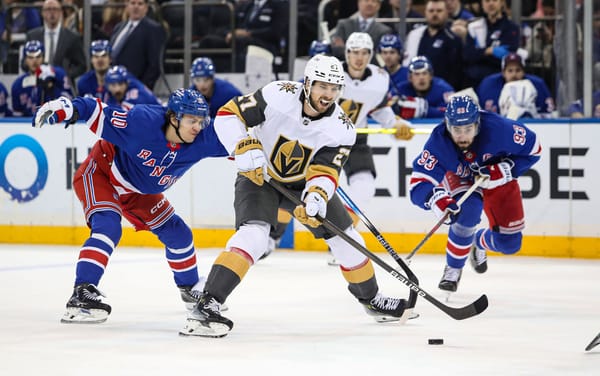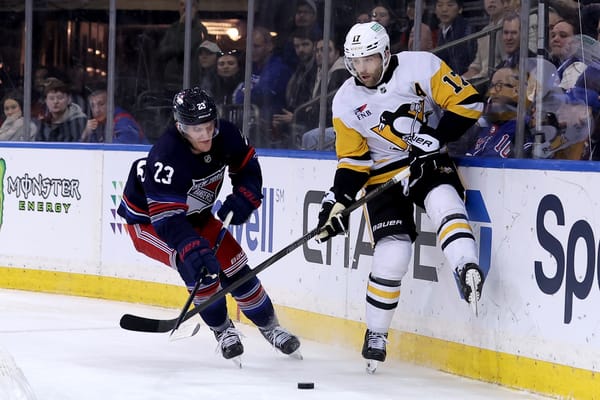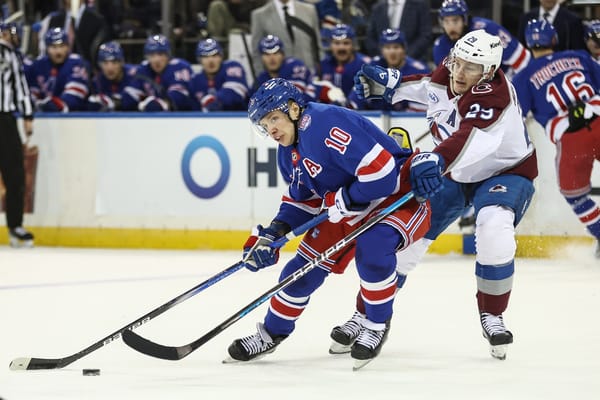Chris Drury’s Next Steps Are Very Important Following Mika Zibanejad Extension
The Rangers went all in on a massive extension for Zibanejad, and Chris Drury needs to map out what happens next very carefully
The New York Rangers made major news on Sunday by announcing an eight-year extension for Mika Zibanejad which will pay him $8.5 million a season starting with the 2022-23 campaign.
8x$8.5M AAV, @NYP_Brooksie first to report https://t.co/sbcHoLSLfc
— Elliotte Friedman (@FriedgeHNIC) October 10, 2021
The opinions on Zibanejad’s new deal are mixed, with those in favor happy that the dynamic goal scorer inked a deal that came in under the rumored figure of $10 million a year, and others being wary of an eight-year pact that will unfold primarily in his 30s.
It is equally fair to love and hate this deal, and I truly feel there’s a way to make a case for both. I’m not a huge fan of the deal personally, but that doesn’t matter for the purposes of this exercise. That said, what ultimately matters is how the Rangers allocate their remaining cap space and assets to build a contender with Zibanejad that is capable of winning a Stanley Cup. A lot of the pieces needed are in place, many of whom will be evaluated this season closely in order to verify they still are on track, but it’s now even more important for the front office to start thinking about the next steps that are going to follow on the heels of this extension.
Zibanejad's contract also includes a full NMC until 7 days prior to the trade deadline in the final year (2029-30)
— CapFriendly (@CapFriendly) October 10, 2021
From the 7 days prior to the 2029-30 trade deadline, until the expiry of the contract, the clause becomes a 21 team no trade list https://t.co/r8vBcFZeME
Using the current roster of players on Cap Friendly, the Rangers have a projected roster size of 16 players, $62,291,469 in salary, and $19,208,531 in cap space following this season. This does not include a new contract for Adam Fox, Kaapo Kakko, Vitali Kravtsov, Sammy Blais, Julien Gauthier, a backup goalie (Alexandar Georgiev, RFA), or a second-line center (Ryan Strome, UFA).
These numbers aren’t likely to change in a meaningful way to the team’s benefit, because the players with the biggest salaries and clauses that allow them to dictate where they play (Artemiy Panarin, Chris Kreider, Jacob Trouba and now Mika Zibanejad) are still going to be around. The current structure has a couple of players making big bucks at the top, and the remainder of the roster making anywhere from $3,641,667 to $750,000. Even if you were to subtract a few in a trade, it is fair to say the return package would have an equal or higher overall compensation.
I don’t think it is unreasonable to say that Fox could take at least $9 million of the projected $19.2 million, and then the Rangers would be in a spot where they need to decide how they want to proceed with Kakko. They could kick things down the road with a bridge deal, or they could make an educated investment on what he could be worth to the team to avoid potentially getting burned later.
A lot of that hinges on how well this season goes, and if the preseason is an any indicator of future performance, 2021-22 could be a big one for Kakko. Ideally the Rangers should be mapping out a scenario in which all their young stars absolutely go off so they can have a hypothetical “all-in” number. Once they have this number, they can start considering what they would have to do to create more space if needed.
Kravtsov, Gauthier, and Blais should be an easier scenario based on their age, role, and relative lack of experience, but will still cost a small portion of the cap. Finding a backup goalie shouldn’t be hard either given how many are routinely available. Replacing Strome, if they decide to part ways, will be interesting unless Filip Chytil has an impactful 2021-22 season that allows him to claim that spot for the foreseeable future.
If the Rangers were able to move on from Strome in-season, it would given them some extra breathing room to plot things out further. That said, while the math may be able to work with these key players, I excluded UFAs like Greg McKegg and Kevin Rooney because they make just $750,000 a piece, you will notice that after factoring in these deals there is limited cap space for roster improvements.
Retaining players is one way teams try to keep contending, but the calculus is a little different when the players being retained are being done so at a level above and beyond their previous salary, and the deal is primarily rewarding past performance. Over the last three years, Zibanejad has had seasons in which he tallied 30 goals and 74 points in 82 games played, 41 goals and 75 points in 57 games played, and 24 goals and 50 points in 56 games played. This stretch covers age 25, 26, and 27, and this production at at price tag of $5.35 million represent immense value.
The rub now is that he’s making an additional $3.15 million a season starting next October, which means the expectations on him will only be heightened. It is quite possible that a coaching change has an impact on some players who may have previously been stifled, and that will have some ancillary benefits for someone like Zibanejad which allows his production to stay in line or increase, but it is less than ideal to pay a player a big raise only to counterbalance it with another player.
Objectively speaking, before drawing any meaningful conclusions about the readiness of the team as a potential Stanley Cup contender, we need to see how returning players perform with Gerard Gallant behind the bench. That said, I think at the very least we can compare the makeup of the current roster to some recent contenders and recognize that there are opportunities to get better, independent of the potential jumps that can and should be taken by the kids.
Even though Zibanejad has been extended, the Rangers should add another top-six center independent of Filip Chytil. And in order to afford one they will need to free up some cap space.
Perhaps the most interesting rift is #NYR are still set to have insane cap space this season. The payraises for Zibanejad (and eventually Fox) don't factor into 2021-22 $.
— HockeyStatMiner (@HockeyStatMiner) October 10, 2021
That being said: it's hard to see any Eichel acquisition unless Kreider or Trouba waive their NMC to leave.
Essentially this player will be someone who is ready to take the top line spot when Zibanejad’s game starts to slip. Independent of his contract, there’s a way the Rangers can utilize Zibanejad once he’s heading towards the back end of his deal, and that will require having someone who can take the big minutes to protect him. Chytil should get an opportunity this year to prove he can be a second-line center, and at age 22 there’s still more than enough time to see what his top-end potential is. Essentially you don’t want to put all your eggs in Chytil’s basket. And in a best case scenario you could have amazing depth with a combination of Zibanejad, a top six addition, and Chytil going 1,2,3 down the middle. Things get dicey if Chytil’s future is on the wing, and if that’s the case he likely becomes an asset in a trade to land a pivot.
So using Jack Eichel as the hypothetical from HSM’s example, although you can insert your favorite big ticket player in this exercise, it is one thing to fit a player in on the roster for this season, but there needs to be sacrifices to make it work going forward.
The team has big decisions following this season, and the year after that it will be time to hand out new deals to Chytil, Alexis Lafrenière, and K’Andre Miller. The reason I bring this up is because any move the team makes in the immediate future will need to consider what these future contracts could cost.
Assuming everyone is healthy, this is what the depth chart looks like this season, and what their status is going forward.
Lafrenière (RFA ‘23) — Zibanejad (UFA ‘30) — Kreider (UFA ‘26)
Panarin (UFA ‘26) — Strome (UFA ‘22) — Kakko (RFA ‘22)
Goodrow (UFA ‘27) — Chytil (RFA ‘23) — Kravtsov (RFA ‘22)
Blais (RFA ‘22) — Rooney (UFA ‘22) — Reaves (UFA ‘23)
Lindgren (RFA ‘24) — Fox (RFA ‘22)
Miller (RFA ‘23) — Trouba (UFA ‘26)
Nemeth (UFA ‘24) — Lundkvist (RFA ‘24)
Shesterkin (UFA ‘25)
Georgiev (RFA ‘22)
One last offseason nugget! Drury you old scalawag...
— HockeyStatMiner (@HockeyStatMiner) October 10, 2021
Despite Zib's extension: Rangers could have as much as $30m to spend at the 2022 trade deadline!
But: they also seem to have fired their last UFA bullet for a while. Look destined to be a 2023 ceiling team (even w/o Strome). pic.twitter.com/LWRrLoV6OP
There’s a true blend of talents who are locked in with clauses, young players who are going to be an important future of this team that will need deals, some tweeners, and players with contracts that could become potential anchors.
This is going to be a very important year of evaluation, and it is going to require some tough decisions. It isn’t out of the question that the front office looks at making improvements to the roster and pays for them by sacrificing some young talent who are due to get paid at a time in which things are tight.
Because there’s no easy way to get out from a contract like Kreider’s or Trouba’s, as both have full NMC clauses until the start of the 2024-25 season, at which point Kreider submits a 15-team no trade list, and Trouba submits a 12-team no trade list. I understand that players with clauses can get moved, but the rest of the league will recognize the situation the Rangers are in, and can use that to their advantage in potential deals to extract extra resources. So this means that if the Rangers look to add top end talent, it could cost them some prospects, young players, or assets to entice the team to retain salary to make it all work financially.
Ultimately, I believe, the success of this team is going to come down to:
- The next steps taken by Lafrenière, Kakko, Chytil, and co.
- The performance of Igor Shesterkin in goal
- Panarin, Zibanejad and other top paid talent living up to their salaries
If one or two of these things don’t happen, the Rangers could be in real tough shape. On paper there’s every reason to believe that they have enough talent to make some noise, and a new voice behind the bench can help push them a little further. Hockey is a weird sport, and just getting into the playoffs opens a lot of doors.
Make all the jokes you want about the Maple Leafs and their inability to get past the first round, but the Montreal Canadiens made an incredible run to the Final after Toronto collapsed, besting the Winnipeg Jets, and Vegas Golden Knights. Look at their roster, and then the Rangers’ current roster, and decide for yourself if you think the Blueshirts could get to the Final based on their skill, and a little luck. The projections for the team are a mixed bag, with the team finishing as high as 3rd and as low as 6th in public models.
Looking over some of the publicly posted models re: #NYR
— HockeyStatMiner (@HockeyStatMiner) October 7, 2021
Pts (Metro rank) Playoffs? [Modeler]
97 (4th) Yes [@JFreshHockey]
96 (3rd) Yes [@domluszczyszyn]
94 (6th) No [@EvolvingHockey]
90 (5th) No [@IneffectiveMath] pic.twitter.com/6elQu0qf52
Based on these point totals and projections, it is fair to say that the team is a piece or two away, even when you factor in strides forward by the kids, and for that reason the organization will need to be swift in making decisions and maximizing value on assets while they still can if they aren’t going to fit into the Rangers’ long-term plan. This includes Kravtsov, could include Chytil, and also applies to non-roster prospects like Zac Jones, Braden Schneider and so on.
Make no mistake, the Rangers are still in a strong position in terms of cap space for this season, and assets at their disposal to facilitate a deal, but they need to take a long look at what they can afford going forward to maximize any additions they make going forward. They ultimately need to lock in the roster they want to use on their journey to win a Stanley Cup, and then try and go for it over the next three to four seasons before the math no longer works.





